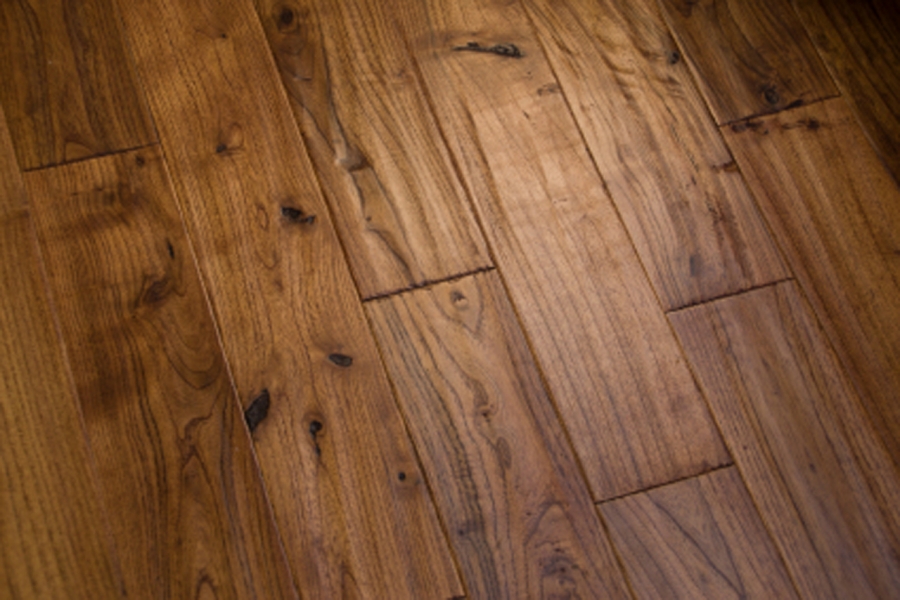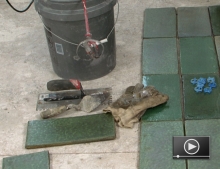Wood Flooring 101
Wood flooring is a long-lasting, aesthetically pleasing, and affordable interior floor covering. According to the National Wood Flooring Association (NWFA), "In a national survey of real estate agents, 90% said that houses with wood flooring sell faster and for higher prices than houses without wood floors." That being the case, who wouldn't want a wood floor? Prior to racing out and purchasing wood flooring, we need to understand what is available and keep in mind that all wood floors are not created equal.

Types
There are two basic types of wood flooring, solid and engineered.
Solid Wood Flooring
Solid wood flooring is milled from a single piece of timber. There are three types of solid wood flooring.
- Strip wood flooring is often considered a "traditional" wood floor. Strips range in thickness from 5/16" to 3/4" and are available in widths that range from 1" to 3".
- Plank wood flooring is distinguishable from strip wood flooring because of its width. Planks are available in 1/2" and 3/4" thicknesses and multiple widths ranging from 3" to 12", in 1" increments.
- Tiles are short in length or are decorative pieces used to create a true solid wood, custom parquet floor. The pieces are cut and placed in a predetermined pattern. Tile thickness can vary from 5/16" to 3/4".
Available pre-finished or unfinished, the tongue and groove strips and planks are arranged in a desired style by using varied lengths, with uniform or varied width pieces. A "traditional" wood floor utilizes uniform widths of strip wood flooring, whereas a "contemporary" or "rustic" wood floor utilizes random widths of strip and/or plank wood flooring. Unfinished solid wood flooring does need to be site finished. After unfinished flooring is installed it will need to be sanded, stained, and then finished with a surface finish urethane or a penetrating finish and wax.
The characteristics of a solid wood floor are defined by the species of wood and its grade. Each species of wood is different and offers varying characteristics. Perhaps the most important characteristic of a solid wood floor is its durability (i.e., its ability to resist wear, denting, and marring). The durability of a solid wood floor is defined by its Janka Hardness Rating (ASTM D-143). Hardwoods, for instance, are more durable than softwoods. As a result, hardwoods are more often used for wood flooring than softwoods. Information on the characteristics, grades, strengths, and mechanical properties of American domestic hardwoods can be found by referencing The Hardwood Council's extremely helpful tool, the interactive Species Guide.
Equally important is a wood floor's appearance. Although personal taste determines whether the appearance of a particular wood floor is aesthetically appealing, grading standards also use appearance as a factor in determining a wood floor's grade. Taking into consideration the amount of distinguishable visual characteristics, grades of wood flooring are not associated with the strength or mechanical properties of a particular wood flooring. Across the various grades these characteristics remain equal. There are many associations, manufacturers, and suppliers that serve the vast market of solid wood flooring, and many have proprietary grading standards. A good example of solid wood flooring grades has been developed by the National Wood Flooring Association (NWFA) and is listed below.
- Clear wood is a flooring product with minimal character marks that provides a uniform appearance.
- Select wood is a flooring product with natural heartwood/sapwood color variations that also includes knots, streaks, etc.
- Common wood (No. 1 and No. 2) has more natural characteristics, such as knots and color variations, than either clear or select grades and often is chosen because of these natural features and the character they bring to a room. No. 1 Common has a varied appearance, light and dark colors, knots, streaks, and wormholes. No. 2 Common is rustic in appearance and emphasizes all wood characteristics of the species.
Solid wood flooring has the capability of being sanded and refinished multiple times during its lifetime, a lasting benefit. Aside from its longevity, natural beauty, and durability, solid wood flooring has its limitations, too. Solid wood flooring shouldn't be installed in areas with high moisture content, such as over concrete floors or below grade in basements. Swelling, cupping, and buckling can occur in solid wood floors when there is too much moisture.
Engineered Wood Flooring
Engineered wood flooring is a manufactured wood flooring. There are three types of engineered wood flooring.
- Wood ply is constructed with a high-quality, finished wood surface layer (lamella) that rests on top of three or more veneer plies. Each of the plies are laid atop one another perpendicularly, glued, and pressed together. Wood ply construction provides the highest-quality engineered wood flooring product.
- Fingered is constructed with a lamella laid atop and perpendicular to a substrate made of small finger-joined pieces of wood. The layers are glued and pressed together.
- Fiberboard is constructed with a lamella laid atop and perpendicular to a substrate of medium- or high-density fiberboard. The layers are glued and pressed together.
Engineered wood flooring should not be confused with laminated wood flooring, which has a paper or plastic image of wood laminated to a substrate. The lamella, or the surface layer of an engineered wood floor, varies in thickness from 0.6 mm to 6 mm. However, it is as durable as a solid wood floor and far exceeds the durability of a laminated wood floor surface. While the lamella is most often a hardwood material, it could also be made from a softwood like pine. Engineered wood flooring can be installed below grade, on grade, or above grade. Similar to solid wood flooring, engineered wood flooring comes in three types.
- Strips range in thickness from 3/8" to 5/8" and are available in widths that range from 1" to 3".
- Planks range in thickness from 3/8" to 5/8" and are available in widths ranging from 3" to 12".
- Tiles are used to create a parquet floor. Tiles that support a geometric orientation similar to true parquet floors are generally 12" x 12" and range in thickness from 3/8" to 5/8".
Engineered wood flooring is only available pre-finished. Similar to a solid wood floor, tongue and groove strips and planks are arranged in a desired style using varied lengths, with uniform or varied width pieces. The appearance and durability of an engineered floor is similar to that of a solid wood floor (the same wood species is used for the lamella of an engineered floor as is used for a solid wood floor). Wood ply flooring is, however, more dimensionally stable than solid wood. This is due to the method used to manufacture it. The increased stability of the product allows for engineered wood flooring to be installed where solid wood cannot: over existing flooring, in basements, and over concrete. Similar to a solid wood, some engineered wood flooring has the capability of being sanded and refinished. However, due to the limited thickness of the lamella, it can be done only once or twice.
Wood Flooring Installation Methods
The installation methods of a solid wood or an engineered wood flooring may vary depending on the application, product, and manufacturer. It is best to read the manufacturer's installation instructions prior to installing any type of wood flooring.
Before delivery of the material, it is necessary to test for moisture and resolve any moisture-related issues. Possible issues that could need to be resolved include an improperly ventilated crawlspace or lack of a moisture barrier, as well as the adjustment of a humidifier, air conditioner, or furnace.
Upon delivery and prior to installation, it is necessary to allow the wood flooring time to acclimate to the environmental conditions of the area in which you intend to install the flooring. Allowing the material to acclimate over a period no greater than 7 days will achieve a balance of moisture between the flooring and the surrounding area.
Prior to installation of the wood flooring the subfloor should be prepared. A wood subfloor should be properly fastened to the joists and the surface should be completely flat. High spots on a wood subfloor should be sanded or planed, while low spots should be built up by using paper building materials. High spots on a concrete subfloor should be ground, while low spots should be filled by using a self-leveling compound.
Primary methods that are commonly used to install wood flooring include the following.
- Nail down uses a cleat nailer and nails to secure wood flooring to a subfloor. Solid wood and engineered wood flooring can be installed using the nail down method.
- Staple down uses a pneumatic gun and staples to secure wood flooring to a subfloor. Solid wood and engineered wood flooring can be installed using the staple down method.
- Glue down uses adhesives to secure wood flooring to a subfloor. Engineered wood flooring over concrete is generally installed using the glue down method.
- Floating is not attached to a subfloor. The wood flooring boards are adhered together or manufactured to allow them to snap together. Floating wood floors typcially rest on top of a pad that is laid over a subfloor. Engineered wood flooring can be installed using the floating method, but solid wood flooring cannot be installed with this method.
Wood Floor Care
After a wood floor has been installed you will want to protect your investment. Generally speaking, doing so is a relatively easy task that involves cleaning and maintaining your wood floor on a regular basis. Keep in mind that water is not friends with your wood floor. As spills or leaks occur, it is best to get them dry as soon as possible. In addition, particles like dirt and dust can act like sandpaper on your new wood floor. It is best to sweep and vacuum the floor often, in order to remove particles from the floor surface and prevent wear and tear.
Should you notice any scuffs, markings, or stains, purchase a professional hardwood floor cleaner to remove the blemish. Prior to initiating a deeper clean, consider the floor's finish and consult with the manufacturer prior to using cleaners and/or waxes. When moving heavy items or furniture, use a dolly to assist you and prevent scratches. Place floor protectors or ventilated rugs (without rubber backing) in high-traffic areas, under furniture, and near wet areas, such as the bathroom sink. Maintain the indoor humidity level between 30% and 50% and the indoor temperature between 60°F and 80ºF. With an appropriate amount of care and consideration, a wood floor should last you a lifetime.

Jeff Calcamuggio
Jeff is an Editor-at-Large for Buildipedia.com who writes and edits Featured At Home and Knowledgebase content. Prior to joining Buildipedia, Jeff's work experience included carpentry, construction documentation, specification writing, construction administration, project management, and real estate property inspection. Jeff is a member of the Construction Specifications Institute (CSI) and an educator at Columbus State Community College and enjoys challenging DIY home improvement projects.


